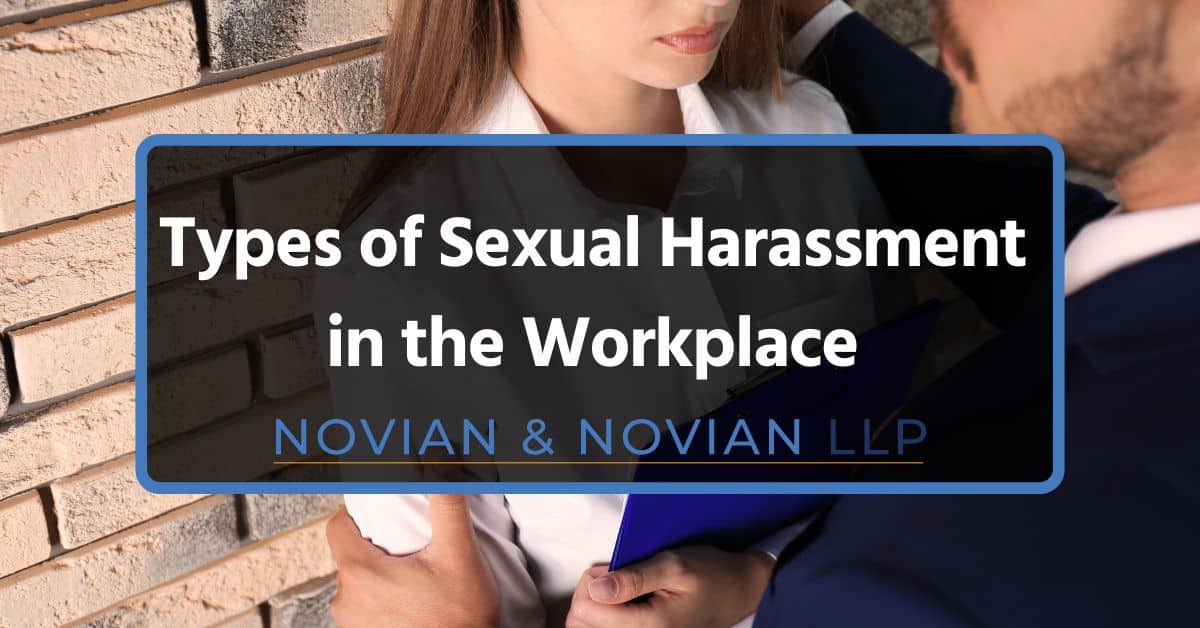
| June 4, 2024 | Employment Law
Sexual harassment ranges from unwanted sexual advances, requests of a sexual nature, and other verbal or physical conduct considered sexually inappropriate. An employee who has experienced sexual harassment is often left feeling violated and distressed. And if proper countermeasures aren’t taken to rectify these situations the employer risks damaging the trust they build within their organization.
With more than thirty-five years of service under our belts, our seasoned sexual harassment claims defense lawyers have helped businesses seeking legal guidance against sexual harassment claims. We offer tailored solutions that ensures your business complies with employment laws and fosters a respectful workplace. Schedule a free consultation to safeguard your legal interests today!
In this post, we will discuss sexual harassment and the many forms in which it appears. We will also take a look at the role of leadership in reducing illegal harassment in the workplace. As well as how you can address sexual harassment when faced with it.
Legal Framework of Sexual Harassment
The U.S. Equal Employment Opportunity Commission (EEOC) defines sexual harassment as “unwelcome sexual advances, requests for sexual favors, and other verbal or physical harassment of a sexual nature”.
To combat harassment, the United States enacted, Title VII Of the Civil Rights Act of 1964, which prohibits discrimination on the grounds of sex, race, religion, national origin, and color. This Federal law applies to employers with fifteen or more employees. It protects them from all forms of discrimination based on various grounds including sex.
Types of Sexual Harassment in the Workplace and Impact
You can better promote strategies that combat sexual harassment when you understand the types of sexual harassment in the workplace. This knowledge not only protects employees but also enhances organizational integrity.
Under Title VII of the Civil Rights Act of 1964, sexual harassment is categorized into two groups; quid pro quo harassment and hostile work environment.
Quid Pro Quo Harassment
This form of sexual harassment refers to situations where something is given/withheld in exchange for something inappropriate. It involves a person superior to you demanding sexual favors for work-related benefits. For example, your supervisor asks you to go on a date with him/her in order to secure a promotion. Or he/she threatens to fire you if you refuse their advances.
An example of Quid Pro Quo harassment is seen in the case of Bihun v. AT&T, Information Systems Inc. The plaintiff (Bihun), claimed her supervisor (Fellows), subjected her to unwelcome sexual advances. Fellows promised to give Bihun any job she wanted if she “played her cards right”. She reported these instances to management several times, but management failed to take any action against him. Ultimately, the court ruled in favor of the plaintiff. This case highlights the legal consequence of failing to prevent and address sexual harassment in the workplace.
The case also demonstrates how sexual harassment undermines the integrity of the workplace. This is because employees quickly lose their trust in the organization knowing that any form of employment benefit is tied to sexual favors. Additionally, any workplace found guilty of this act will most likely experience high turnover rates, leading to increased recruitment costs. This is because their employees would want to work in a safer environment.
For the victim, quid pro quo harassment can be damaging professionally and personally. From a professional viewpoint, the employee may succumb in order to secure their job and advance in their career. This often leads to job dissatisfaction. From a personal standpoint, quid pro quo harassment comes with severe psychological effects. This leaves the victim feeling depressed, humiliated, and anxious. In summary, this form of harassment in the workplace has the potential to damage the well-being and career prospects of its victims.
Hostile Work Environment
A workplace is said to be hostile when unwanted sexual advances make the environment feel hostile, offensive, or intimidating. This form of sexual harassment could be verbal, physical, or visual.
Verbal harassment in the workplace involves sexual jokes and inappropriate remarks about a person’s appearance. Whereas, physical harassment takes the form of unwanted physical contact. On the other hand, displaying sexual images or vulgar emails are examples of visual harassment in the workplace.
In Burlington Industries, Inc. v. Kimberly B. Ellerth, the court examined Kimberly’s assertion of enduring a hostile work environment. She accused her supervisor of sexual harassment. Though the harassment lacked tangible job consequences, it contributed to a hostile atmosphere. Ultimately, the court determined that her employers could be held accountable for the supervisor’s sexual harassment, irrespective of the presence of tangible job consequences.
Ultimately, a hostile work environment hurts productivity. Sexual harassment victims working under such conditions are often demoralized and tend to avoid their workplace more. As the pressure increases, employees feel unsafe and undervalued. This causes job satisfaction to plummet, and turnover rates to skyrocket. Repeated exposure to inappropriate behavior creates a stressful environment for employees. The ongoing hostility can go beyond the workplace and extend to the employee’s personal relationships, thereby reducing the quality of their overall well-being.
A hostile environment created by sexual harassment not only undermines workplace efficiency but inflicts severe psychological and professional harm on the victim. This makes it essential for organizations to enforce policies that prevent such behaviors.
Non-Physical Forms of Sexual Harassment – Verbal Harassment
Verbal harassment can have a significant impact on the individuals affected. When behaviors like this are left unchecked it can escalate in several harmful ways. When verbal harassment is tolerated, the perpetrator gains courage. This could lead to more frequent and severe forms of harassment. Verbally abusive statements usually look like the ones below:
- “You look sexy in that dress, you should wear stuff like that more often”
- “If you really want that promotion, you should consider coming over to my place for drinks tonight”
The ongoing harassment can lead to feelings of helplessness, shame, and a decreased sense of self-esteem in employees. Additionally, such behavior leads to a decline in morale among employees. Ignoring sexually abusive statements results in more severe harassment, high turnover rates, legal issues, and reputational damage. Companies should take immediate effect against sexual harassment.
Non-Physical Forms of Sexual Harassment – Visual Harassment
Examples of visual harassment can be setting your screensaver to an explicit/ inappropriate image that can be seen by others in the office. Sharing images, memes, or videos of explicit content via email or messaging apps in the workplace is also a form of visual harassment.
Workplaces that condone visual harassment degrade the morale of their employees and leave them feeling unsafe. Failing to address it can lead to financial and legal repercussions such as lawsuits.
Non-Physical Forms of Sexual Harassment – Digital Harassment
This is the use of electronic communication tools to threaten, intimidate, or embarrass someone. It includes sending abusive emails, texts, or social media posts on a non-consensual basis. This form of sexual harassment often targets victims repeatedly causing significant emotional distress. It is considered extremely pervasive because it can happen anytime and anywhere.
Imagine two coworkers Sarah and Paul. Sarah sends Paul emails daily that contain inappropriate sexual jokes. Despite asking her to stop on multiple occasions, she continues. In addition, she is now leaving lewd comments under his social media posts. The constant intrusion has left Paul feeling unsafe and has hindered his ability to focus at work. This is an example of how digital harassment occurs.
How to Respond to a Sexual Harassment Claim
When faced with a sexual harassment claim it is important to respond immediately, and impartially. This involves taking the claim seriously and ensuring the victim feels heard. The company should investigate the case while maintaining the confidentiality and safety of the victim. If the company’s investigation proves the harassment happened, corrective actions should be taken against the perpetrator. Firstly, the prevention of retaliation against the victim of harassment is crucial. Additionally, the company can provide counseling sessions or other forms of support to the victim if needed. Secondly, employers should review their anti-harassment policies to prevent future incidents. Typical legal requirements include implementing anti-harassment policies and providing training to all employees. These are the basic steps taken in responding to a sexual harassment claim.
Addressing and Reporting Sexual Harassment
Companies have different ways of reporting harassment in the workplace. Employees can either report such cases to HR or through an anonymous channel. It is the responsibility of organizations to ensure their employees are kept safe by providing confidentiality and protection against retaliation.
Building on these methods to address sexual harassment, if you find yourself experiencing or witnessing sexual harassment in the workplace, we advise you to first record the incident. Be as detailed as possible as this forms part of the evidence you can present in court if it results in a lawsuit. The next step is to report the harasser’s inappropriate behavior to a supervisor or Human Resources (HR) as soon as you can. If your organization has an established channel for reporting such incidences follow it.
Company policies and trainings play a crucial role in preventing workplace sexual harassment. Clear policies outline acceptable and unacceptable behavior, as well as the consequences of engaging in sexual harassment. It also teaches employees the best way to report offensive conduct. This creates a safe environment for employees and reduces the likelihood of harassment occurring.
Role of Leadership in Preventing Sexual Harassment
Leadership is essential in maintaining and promoting a culture that prevents sexual harassment. Leaders bear the responsibility of preventing sexual harassment by enforcing anti-sexual harassment policies and promoting a zero-tolerance stance. They should openly express their commitment to creating an environment free from unwelcome sexual advances. Additionally, they should also ensure reporting channels are made available for victims.
Other effective policies for preventing sexual harassment include a clear definition of workplace harassment, detailed reporting procedures, and strict consequences for sexual assault. Leadership actions such as providing sexual harassment training also show commitment to deterring harassment.
Strong leadership is essential for creating a safe environment for employees. By enforcing clear policies and modeling appropriate behavior, leaders can effectively address workplace harassment.
Fear of Retaliation to a Sexual Harassment Claim
Anything that reduces an employee’s willingness to report sexual harassment may be classified as retaliation. An employer may retaliate after an employee reports a sexual harassment case. Forms of retaliation include terminating the employee’s contract, demoting them, or subjecting them to increased scrutiny.
Title VII of the Civil Rights Act makes it unlawful for employers to retaliate against employees who have been sexually harassed and reported such cases. The Equal Employment Opportunity Commission (EEOC) is the body that enforces this protection, ensuring victims who experience retaliation can file a case with the EEOC.
Employers who are found guilty are liable to legal consequences like penalties and compensation to the affected employee. The goal of this legal framework is to encourage reporting of sexual harassment cases without fear of retribution.
What Happens if a Sexual Harassment Claim Goes to Court?
When a sexual harassment claim goes to court several factors determine the amount of time needed to resolve it and the settlement amount. If you decide to file a lawsuit you have to draft and file a complaint with the appropriate court. The next step is to gather as much evidence as possible. For victims gathering evidence means being able to present anything that serves as proof of your claim. This could be detailed notes, emails, recorded phone calls, and even presenting a witness.
After all evidence has been presented, you can either negotiate a settlement or proceed to court. According to the U.S. Equal Employment Opportunity Commission’s 2019 report, around 54% of employee discrimination cases, which include sexual harassment claims, were closed within 10 months.
This swift resolution often involves reaching a settlement agreement with the average settlement for harassment lawsuits being approximately $50,000. However, for a more accurate estimate based on your case, you should contact a sexual harassment lawyer.
Need advice on handling Sexual Harassment Claims?
There are two major types of sexual harassment in the workplace: quid pro quo which involves explicit or implicit sexual favors for workplace benefits. And hostile work environment which is characterized by repeated offensive sexual behavior.
To cultivate a respectful and safe environment devoid of unwelcome sexual advances, it is important to remain aware of these forms of harassment. Additionally, employers should show their commitment to fighting sexual harassment by implementing policies that support employee dignity and safety.
Novian & Novian LLP’s distinguished business attorneys offer expert legal counsel for businesses. With a history spanning over three decades, our firm is committed to delivering exceptional legal solutions to your needs. Employers who lack expertise on matters concerning compliance with sexual harassment laws should seek guidance immediately. Book a free consultation to address your compliance concerns with one of the best Los Angeles Employer Defense Practices.
Contact Us
Have questions about this post? Novian & Novian is a full service law firm in Los Angeles with clients that span the country. Contact us today for a free consultation.
Contact Us
Have questions about this post? Novian & Novian is a full service law firm in Los Angeles with clients that span the country. Contact us today for a free consultation.





